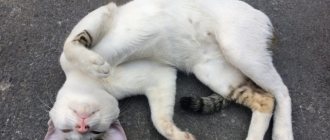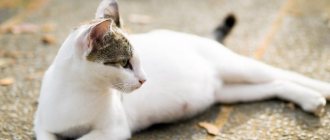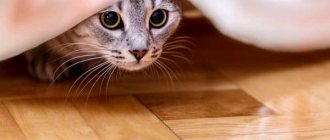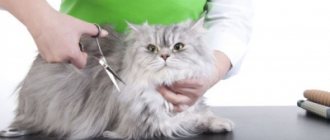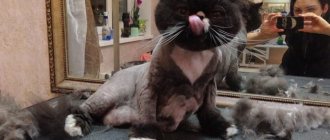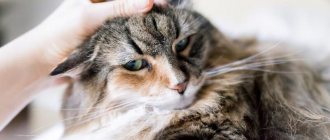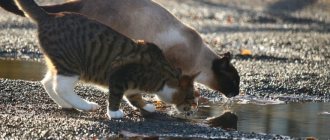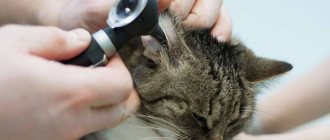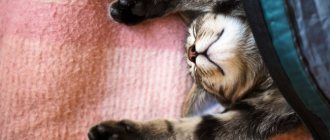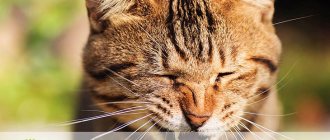Many people worry about their cats getting fat, but unintentional weight loss can also be a serious problem. This could be a sign of a serious health problem.
Depending on the cause of your cat's weight loss, you may notice that your cat's appetite has decreased or disappeared completely, a condition known as anorexia. This is dangerous for cats because they are prone to something called hepatic lipidosis, or fatty liver syndrome, a life-threatening condition that can develop when the liver must process large amounts of stored fat to provide the body with energy.
But there are other medical situations that may cause your cat to lose a lot of weight, even if she continues to eat a normal amount of food.
Regardless of whether your cat is eating or not, if you notice that she has lost weight, it is important to consult your veterinarian. If you are unsure what your cat's ideal weight should be, your veterinarian will be able to provide guidance and suggest a feeding regimen that suits your cat's nutritional needs.
© shutterstock
Deviation or norm?
Before taking any measures, you need to make sure that the pet is really very thin. Each breed has its own average performance. For example, outbred cats weigh from 3.5 to 4.5 kg, British and Siberian breeds - from 5-7, Maine Coons - from 8 to 12.
© shutterstock
Lack of weight can be determined by palpating the animal's body. If the ribs are well felt and the fat layer is insignificant, this is a deviation from the norm. In cases where the physiological causes listed below are excluded, consultation with a doctor is required.
An alarming sign is if the cat looks thin visually, its ribs, spine and pelvic bones protrude, and there is no fat layer . The stomach is sunken, and the silhouette resembles an hourglass. Such signs indicate exhaustion of the body. A veterinary examination and serious treatment is required.
Is a cat thin or plump - how to determine the norm?
For purebred purrs, a standard is prescribed, which provides detailed characteristics of the mustache and the boundaries of the minimum and maximum body weight, as well as height. If you are the happy owner of a mongrel or yard pet, then you will need to carefully examine and palpate your favorite creature:
- Position your pet so that the front legs are level and the hind legs are at a slight angle, moving more towards the tail.
- Feel the antennae's ribs and spine. If the spine is smooth without excessive convexities and only the outer ribs are felt to the touch, then this is normal.
- Feel the pelvic area - the croup should be smooth, and the joint bones should not protrude much.
- It is considered normal if the pet’s belly sags a little or is tucked up. When moving, a fold appears in the abdominal area.
- If a slight layer of fat is felt on the chest and abdomen, then this is quite normal.
- In the cold season, there may also be small layers of fat on the sides and this is good.
If you clearly see protruding ribs, pelvic bones, spine, a large depression in the peritoneum, and in the area of the forearms, chest and hind limbs the muscles seem to be hanging down, then the cat is clearly underweight.
Many owners believe that their fluffies are too thin, but it is important to understand that some breeds are characterized by such a constitution. These mustaches usually have a good muscular corset and a good appetite.
It is important to understand that all mustaches are individual and you should not compare your favorite with your neighbor’s.
Why is the cat skinny?
A cat may look thin for completely natural reasons. In most cases, with a good appetite, the animal soon begins to recover and returns to normal. Natural (physiological) reasons include :
- Feeding offspring - the thinness of a cat during the period of feeding kittens should not be a cause for concern. The female will recover after the cubs switch to regular cat food.
- Mating period - during the mating season, cats tend to lack appetite due to hormonal stress. This is especially true for animals accustomed to walking on their own.
- Stress – Cats can become stressed in certain situations. At the same time, the animal loses weight because it eats little or refuses food. The reason may be a move, a change of owner, or the arrival of a child, another cat or dog in the house.
- Changing food - if a cat is offered a new food, he may eat it less or refuse the treat altogether. If over time the animal does not adapt, it is necessary to return to its usual diet.
- Age – If the pet is young, overly active, often plays and moves a lot, weight loss is considered a natural consequence. Older cats also tend to become thinner as the body stops storing fat. In this case, it is necessary to visit a veterinarian to rule out diseases.
Physiological reasons do not cause concern, but you can pay attention to the animal’s diet - whether it is healthy and nutritious enough.
© shutterstock
It’s bad if the cat shows signs of exhaustion, this indicates the presence of diseases. If the cat has lost a lot of weight, most likely the reason lies in one of the pathologies :
- Parasites – helminths – are a very common cause of pet thinness. Helminthic infestation disrupts the animal's digestive processes. And the waste products of parasites lead to intoxication of the body. Therefore, it is important to give your cat anthelmintic drugs on time.
- Infectious diseases - diseases such as calcevirosis, panleukopenia, viral peritonitis and rhinotracheitis are accompanied by dehydration and lack of appetite. Symptoms: discharge from the nose and eyes, diarrhea, high fever. If these signs appear, you should immediately contact a veterinarian. Lack of timely treatment can lead to death.
- Oncology – the presence of malignant tumors can also cause exhaustion. If a tumor is suspected, the veterinarian will prescribe an ultrasound.
- Teeth and gums – it happens that a cat cannot eat for dental reasons. If an animal is interested in food, but cannot eat, it is necessary to show it to a specialist.
- Other diseases – almost any disease can lead to weight loss. A cat loses weight if it has problems with the kidneys, liver, heart, thyroid gland, metabolic disorders, or viral diseases. An accurate diagnosis can only be made by a qualified specialist.
Any of the pathologies requires immediate veterinary intervention. Only a veterinarian can determine why a cat is thin and prescribe the necessary treatment. A preventive visit to the clinic once a year is also recommended to check the general health of the animal.
Loss of appetite in a cat
The goal of treatment is to find the underlying cause, provide treatment, and provide support.
A set of measures aimed at solving:
- Encourage your cat to eat because nutrients are very important for her recovery. Offer very tasty foods such as tuna, shrimp, shredded chicken or a very tasty paste such as Nutrigel.
- Use appetite stimulants.
Mirtazapine is an antidepressant that can also stimulate appetite. Maropitant citrate is an antiemetic (vomiting agent) that can also relieve nausea, which is a common reason why cats lose their appetite.
In some cases, mirtazapine and maropitant may be used together.
Other appetite stimulants include cyproheptadine (Periactin), an antihistamine, and corticosteroids such as prednisone.
- Use a feeding tube.
If the above methods do not work and your cat is still not eating, you may need to tube feed your cat until her appetite returns. The feeding tube is a plastic tube that is placed either through the nose (naso-esophageal feeding tube), through the skin of the neck and into the esophagus (esophagostomy feeding tube), or through the abdominal wall and into the stomach (gastrostomy feeding tube). Soft and watery food is placed in the feeding tube to ensure your cat has enough nutrition until her appetite returns. Once the tube is inserted, the cat can be treated on its own at home.
- Antibiotics to treat bacterial infections.
Supportive care – such as fluid therapy to treat dehydration and anticancer drugs.
Non-medical causes of anorexia:
- Dirty food bowls and trays pose a natural risk because old (stale) food has an unpleasant odor. It is necessary to regularly wash your cat's dishes in hot soapy water once a day.
- Sharing a food bowl. Cats are not social eaters, they prefer to eat on their own, so if you have several cats in the house, stick to the rule that each cat should have its own food bowl.
- Eating space is very important. Food and water cups should not be placed in close proximity to trash cans. Bowls should be located in an area that is easy to access but subject to high traffic.
- Sudden changes in diet. Cats that have been fed one type of food are very sensitive to changes in diet. If you want (or need) to change your cat's diet, do it over the course of a few days. Start by adding a small amount of the new food to his regular food and slowly increase the amount of new food. Loss of appetite is often one of the first signs that your cat is not feeling well. Always be vigilant and aware of how much your cat is eating and whether a loss of appetite needs to be consulted by a veterinarian.
- Having several animals in the house. Providing each member with their own place to eat will allow them to feel calm while eating.
Alarming symptoms
If the cat is very thin, first of all it is necessary to observe his condition and behavior. The following symptoms should cause concern :
- unpleasant odor from the mouth;
- lethargy, decreased activity and apathetic state;
- increased body temperature;
- diarrhea or constipation, vomiting;
- purulent discharge from the eyes;
- refusal of food.
These signs can occur with helminthic infestation, infections, gastrointestinal disorders and other serious diseases. If one or more symptoms are detected, the animal should be examined by a veterinarian.
© shutterstock
Physiological causes of weight loss
- Presence of offspring. If the pet has become a nursing mother, then she will have a strong appetite, but at the same time she may lose weight, especially if there were a lot of babies in lambing. After finishing feeding, mommy will immediately begin to recover.
- Anxiety. When a change of residence occurs or a pet does not see its owners for a long time, it experiences stress, which can affect its body weight, even if it eats well.
- Mating season. This point especially applies to those mustaches who have access to the street. In the spring, when they are looking for a mate, there is a big waste of energy and the fluffies in love lose weight.
- Hunger and change of usual food. If for some reason your pet is starving, then she will certainly lose weight, but a change in food can also affect her weight. Very often, when switching from a natural diet to commercial food, fluffies begin to lose weight because they do not accept the new food. In this case, there is no need to rush - do everything gradually and add food in small portions to the overall diet. When switching to another food that is unusual for the animal, be sure to monitor its weight.
- Age. Older pets lead a less active lifestyle, eat less and, as a result, lose weight (here it is important to exclude age-related cat diseases from a veterinarian).
Health problems as a cause of weight loss
- Dysbacteriosis. Some pets have metabolic problems from birth, while others suffer from it due to poor quality nutrition. In such a situation, it is necessary to adjust the cat’s menu and add vitamins and probiotics to it. The doctor will help you determine which probiotics your mustache needs after passing the tests.
- Presence of microparasites. Deworming needs to be done regularly.
- Dental problems. Inflammatory processes in the gums and tartar cause discomfort and the cat (even a hungry one) refuses treats. Here you need the help of a specialist.
- Oncology. Neoplasms in internal organs have a bad effect on a cat's health. If you don’t understand why your domestic cat is thin and not getting better, then first of all rule out the presence of tumors and do an ultrasound.
- Presence of internal diseases and infections. In addition to emaciation, your pet may experience other symptoms: vomiting, fever, change in stool, refusal of treats, etc. - all this signals some kind of pathology (disease of the gastrointestinal tract, liver, kidneys, etc.). At the same time, the cat may have “caught” an infection - panleukopenia, viral hepatitis, etc. Timely diagnosis is necessary here. Curing the disease will lead to weight gain.
What to do to get your cat to eat
There are many ways to get your cat to eat. However, your most important job as a pet parent when your cat isn't eating is to monitor her physical health.
If your pet's loss of appetite lasts more than a few days, you should contact your veterinarian. Once you and your veterinarian have ruled out any physical problems or illnesses, you can begin to follow these tips.
- New food . Getting your cat to eat can be done by simply changing what they eat.
- Reduce anxiety . If your cat picks up on your anxiety, try cat yoga. This will calm you down and help you build a positive relationship with your kitten.
- Appetite stimulants . You may need to consult your veterinarian if your cat is still not eating after a few days.
